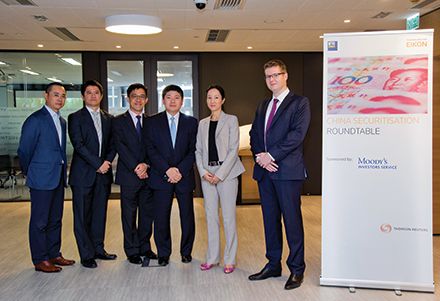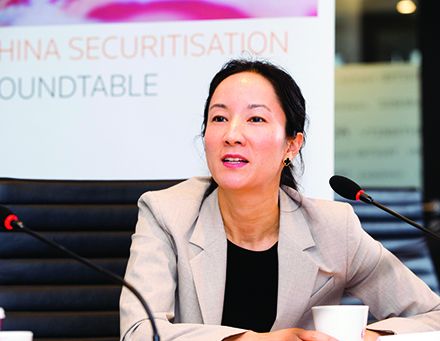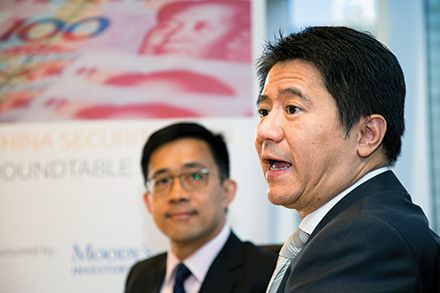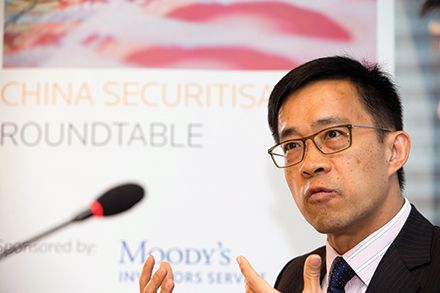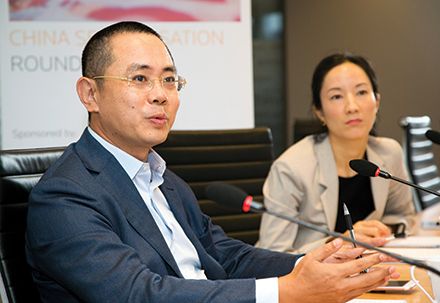IFR ASIA: Welcome. Jerome, most of my research for this discussion comes from your note from a couple of weeks ago, so the first question is for you! What makes China securitisation an area of interest for the international community?
JEROME CHENG, MOODY’S: First of all, the Chinese regulators reopened the securitisation market in mid-2012, because they recognised that securitisation can be used as a financial tool to help reform the economy and monetise assets. Since then, various regulators have been very supportive. The PBOC and CBRC have re-launched their securitisation pilot scheme, and the CSRC has updated its specific asset management plan.
This has allowed different organisations to sponsor securitisation transactions for various purposes. Some – especially the banks – look at it for balance sheet management, so that they can free up capital or reduce their risk exposure.
For auto finance companies, they have been very active because securitisation offers them a very good funding alternative. Before securitisation, their main source of funding was from bank loans or intercompany loans. Securitisations allow them to reach out to a different pool of investors at very competitive pricing.
Some other companies have been using a specific-asset management plan, or also known as asset-backed-specific plan, as their funding platform. Again, this platform offers them another funding alternative.
It has been a very active year for NPL securitisation because it has helped some of the banks manage their bad loan portfolios.
IFR ASIA: That always surprises me. How do you securitise assets that are not performing? Does that make any sense?
JEROME CHENG, MOODY’S: NPLs have been securitised, for instance, in Korea, in the US, and in Italy. Similar to any securitisation, you are relying on the expected cash flow from a pool of assets. Although the expected cash flow from a non-performing asset pool may not be as high, it doesn’t mean that you won’t be able to receive anything. Some NPLs are backed by real assets, so you can make a projection on the rate of recovery.
Of course, the analysis of an NPL transaction is much more complex than that for other performing assets. There will be a certain degree of uncertainty.
IFR ASIA: Lesi, so is the main opportunity in China securitisation now dealing with banks who are looking to free up capital?
LESI ZUO, STANDARD CHARTERED: As Jerome mentioned, there are many different considerations for banks or corporates using ABS. I don’t think freeing up capital is the main driver in the current marketplace. For example, most of the auto finance companies are using this mainly as a funding tool. Auto finance companies in China have limited funding options, and ABS is a good tool to provide capital market funding matching the duration of the assets. In an efficient market it can offer pretty competitive and diversified source of funding, and that are driving all the auto finance company issuances.
CRISTINA CHANG, CITIGROUP: I think it’s quite a healthy trend that funding is now the key driver for a lot of the auto finance companies to look at securitisation. It means that they are keeping a significant amount of first-loss risk, so their interests are aligned with investors. They continue to service the assets and hold them on their balance sheet, and investors recognise that these are high-quality investments with a significant track record.
There is also a broad range of issuers in this asset class, so investors are now able to compare the performance of different issuers. They can also compare underwriting and servicing policies to really start to understanding the asset class in a lot more detail, consistent with what we’ve seen the international investor market.
IFR ASIA: Is it fair to say the auto sector in China is already quite mature?
CRISTINA CHANG, CITIGROUP: I think it’s definitely maturing. The ABS market has made a lot of progress since it opened two years ago, and overall the auto-financing market has matured. I think a lot of the progress is thanks to the international auto-finance captives coming into China and implementing global standards in respect of underwriting and servicing as they build up their financing platforms there.
KYSON HO, HSBC: It’s also part of another trend – the globalisation of the renminbi. When we look at the Chinese ABS market, even though most of the issuers are onshore and most of the investors are onshore, we see in certain sectors it’s becoming very globalised.
Everyone has talked about the auto sector. Globalisation to me is more than just bringing outside best practice to the onshore market. It is also how the local market develops best practices globally. For example, beyond the auto sector, we are seeing some local issuers, like local banks, doing RMB securitisations with international ratings and targeting offshore investors.
This globalisation of the ABS market at HSBC we view as very much part of the globalisation of the RMB.
JEROME CHENG, MOODY’S: One thing worth mentioning here is that the regulators in China have done a lot to uphold market standards and promote best market practices. They are really trying to introduce them into China’s onshore market. In China, we now have many multinational auto companies and the international rating agencies.
That’s why it’s phenomenal when we see onshore deals rated by international rating agencies. It’s unique in Asia’s local securitisation markets, and I think that it paves the way for international investors to participate.
IFR ASIA: I want to talk a bit later about foreign investors, but how is the regulation changing? A lot of different authorities are all stimulating this part of the market. What’s going on there?
ROY ZHANG, KWM: I think it’s good and bad that we have different regulators rather than different markets. In a sense they are competing with each other. Everybody is promoting issuance on a registration system rather than an approval-based system, so that’s why we’re seeing more international standards in terms of structuring and documentation.
We’re seeing the regulators, including NAFMII and CSRC, issuing various guidelines to let the market know really what they see as the fundamentals for the market to develop. So that gives very clear guidance to market practitioners, which is quite different from other cases where you are dealing with the NDRC or some other body when you have to work around challenges or questions. In some sense, I think that’s quite a courageous approach from the regulators.
IFR ASIA: You say they’re competing, but is there some common ground? Is there a common drive to grow the securitisation concept?
ROY ZHANG, KWM: Not really, but the market is big enough. For example, the CSRC (which regulates the exchange market) is trying to do more deals using a trust structure and trying to have more bank investors participate, but it’s a different investor base from the interbank market. We are seeing some conversions between the two markets. Recently, we have been working on several cross-market deals. That’s a big development.
LESI ZUO, STANDARD CHARTERED: I think there is some high level coordination, but the different regulators have their own focus. So far we have seen some benefit from this.
KYSON HO, HSBC: NAFMII has also introduced structured asset-backed notes (ABN) as well. So corporates who used to only be able to issue securitisation paper under the CSRC scheme can now tap into the interbank bond market through the trust structure ABN.
The ABN framework is basically very similar to the credit asset securitisation scheme regulated by PBOC and CBRC. So the whole arrangements will give investors more legal protection.
IFR ASIA: Kyson, you mentioned one appeal of securitisation is the chance to bring in new investors. So is that driving these cross-market ideas? How diverse is the investor base really?
KYSON HO, HSBC: Let’s talk about two groups. The Chinese market is blessed in the sense it has a very big base of domestic investors which are very diverse. So you have banks, you have funds and then to some extent in the interbank bond market you also have insurance companies.
Then you have the international investors and they come in different phases. A few years ago everyone was talking about R-QFII. Those rules were relaxed in 2016 so we’re talking about new jurisdictions, and then we have the introduction of the renminbi in the SDR basket. All of a sudden some international investors had to buy more renminbi assets. So they look at the asset class they are most comfortable with and see an international rating and a global structure.
In that sense China is blessed with a very large universe of domestic investors plus increasing international participation. I think that’s what makes it exciting.
IFR ASIA: So where have we seen international investors buying? What do they go for?
KYSON HO, HSBC: International investors clearly started looking at the auto sector, because it was the first asset class with international ratings. In 2016 we also had the first RMBS with an international rating.
International investors tend to like diversity, while many of the domestic investors are happy with a more concentrated CLO portfolio.
LESI ZUO, STANDARD CHARTERED: Frankly speaking, there is some participation from international investors but it’s definitely not significant.
I have some data points around ABS investment in the interbank market. The ratio now is around 50/50 between banks and non-banks, which includes banks’ asset management plans. So basically the banks’ asset management departments are buying the paper, putting them into asset management plans and distributing to retail and institutional investors.
This is very significant from a regulatory perspective, as you want to see banking assets distributed through this product to non-banking investors. If you look at the data over the last couple of years actually you can clearly see a trend in banks’ own account investment being reduced.
IFR ASIA: That’s more diversified than I was expecting.
LESI ZUO, STANDARD CHARTERED: Exactly. Also going back to the point about international investors, at the very beginning of this market development – not only just for ABS, for all the products in the interbank market – international investors had to participate through QFII or R-QFII, which is not practical for investors wanting to come in to invest in one particular transaction and wanting to get money out after the transaction matures.
Earlier this year, PBOC opened up the interbank market for real money international investors – such as banks, insurance companies and mutual funds. Now technically they can come into China and open investment accounts.
Frankly speaking, direct investment into ABS is still very limited at this stage for a variety of reasons. It’s not just the understanding about the market. It’s also about what kind of return ABS paper offers compared to elsewhere. After asset swaps, the yield is sub Libor given the currency depreciation. Why would international investors come to invest in Chinese ABS paper when they can get Libor plus 20bp–30bp on Triple A rated US credit card paper?
CRISTINA CHANG, CITIGROUP: I think there are a few different aspects around this. Obviously one is to what extent our international investors can access the onshore market. As Lesi mentioned, it has been fairly limited. There are two types of international investors here: those that have a presence onshore in China, for example an international bank with an onshore entity; and true offshore investors. The first group has been quite active, particularly in the earlier years, and we have also seen true offshore funds investing through QFII quotas.
Both of these groups are more price-sensitive than real local investors who need to invest regardless of the pricing. So in the earlier years, when pricing was relatively high, there was an opportunity for international investors, but a lot of them just withdrew from the market when pricing tightened to the 3% level.
More recently we’ve seen pricing widen a little bit, and international investors have started to look again. But they’re never going to be the core part of the investor base. The core will come from local Chinese investors that have liquidity that needs to be put to use.
IFR ASIA: If you’re VW or BMW, you probably don’t want all your existing investors to follow you into China anyway.
CRISTINA CHANG, CITIGROUP: That’s right. The other aspect of internationalisation is how deals are structured. As people have mentioned, the presence of international arrangers and international auto finance companies has been helpful. The international rating agencies have also been very important, not just in providing an initial rating for transactions, but through ongoing review and commentary. That shows investors and originators how they should be reviewing and assessing transactions as they perform over time.
Moody’s has done a great job of presenting the performance of all the transactions so far. It really encourages transparency and makes issuers much more sensitive about the performance of their transactions over time.
IFR ASIA: That’s your cue, Jerome! How different is your approach in China versus elsewhere?
JEROME CHENG, MOODY’S: The overall general rating approaches are the same, because we apply a global standard. Of course, when we look at specific asset classes, then we need to study the legal framework, the regulatory framework, and the specifics of the asset type.
For instance, operational risk in China may differ from other jurisdictions. In the US, loan servicing is a very developed market, so it’s very easy to find backup servicers. In China, no standard third-party servicer is available at the moment.
One point I want to go back to is Cristina’s comment about international investors. Price is definitely one of the main considerations, and potential currency depreciation also makes it more challenging. But we understand that many investors are actually very interested in at least studying the market, even if they may not have actually invested yet. From the quota registrations, investors can see how many deals are in the works from different originators, and they see that it’s worth spending time understanding the market because there will be a continuous deal flow.
As Cristina mentioned, Moody’s has been making numerous efforts to promote market transparency. We have rated quite a number of the auto ABS transactions sponsored by international captive finance companies, because these are the products that appeal to international investors. We have been publishing a quarterly report on their performance, comparing different asset classes as well. More importantly, we have also published cross-jurisdictional auto ABS comparisons. Such comparisons line up Chinese auto ABS with similar products in other markets, like in Europe and the US, to make it easier for international investors to compare and contrast.
We hope that this gradual process of education will attract more and more investors. Of course, the bottom line is that the return on investment also has to make sense.
IFR ASIA: Talking about credit concerns, is there now enough data for investors to gauge performance? Lesi, is the track record a problem when you’re trying to sell a deal?
LESI ZUO, STANDARD CHARTERED: If you look at the performance so far, it’s exceptionally good. However, there hasn’t been an economic downturn in China yet, so you could say it’s not been tested, but there are other factors behind this strong performance.
The auto loan sector is a good example. The younger generations are getting more and more used to making big purchases with credit. We’ve seen some of the auto companies using financing provided by their captive finance arm as a promotion tool – zero interest rates, for example. In that case the manufacturer is going to subsidise the finance company, and customers find the repayments very affordable. Even in some stressed scenarios I think those borrowers will have no problem to pay.
Another point to note is the low loan-to-value. In China the LTV has been regulated, so that’s why you have more equity in the deal to start with. The whole infrastructure has been improved, with credit bureaus monitoring performance. All of these contribute to a strong performance.
JEROME CHENG, MOODY’S: Definitely, there is some historical data available in China. We can go back more than 10 years, depending on the products at which you’re looking; but we also have to factor in some considerations in analysing historical data. First of all, the pool size has grown significantly over those 10 years, so we have to think about growth, the rationale behind it, and its implications for future performance. The second consideration is that the China market is evolving, and it’s changing quite rapidly. For auto loan receivables, as Lesi mentioned, the portfolio is also changing. For instance, younger consumers borrow more, and loan origination will move inland, not just concentrating on the coastal areas. This trend may change the performance matrix.
Another consideration is the benign economic environment. The Chinese credit markets are not as mature as the more developed markets, so it’s not clear what will happen if a crisis hits. How people will respond to a scenario of increasing personal leverage remains to be seen.
Having said that, there are also some positive features. First of all, the general leverage ratio is still relatively low when compared to other markets. The saving rate in China is also relatively high. Another positive factor is the information that is available from the PBOC credit bureaus. This system is quite good, because all financial institutions are required to report positive and negative information. That means originators with access to these credit bureaus can actually look into the behaviour of underlying borrowers, helping originators strengthen their underwriting.
IFR ASIA: That’s not going to work on every asset though, is it?
JEROME CHENG, MOODY’S: It will depend on the product and the asset, that’s true. For some of the products, you have better historical records at the PBOC’s credit bureau.
To view all special report articles please click here and to see the digital version of this report please click here.
To purchase printed copies or a PDF of this report, please email gloria.balbastro@thomsonreuters.com.
